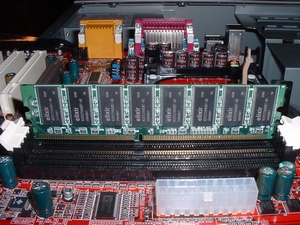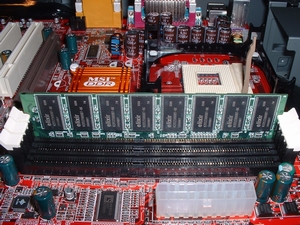The relation of memory to the
actual perceived speed of a computer is always going to be a bit nebulous, as it
is governed by so many other factors. To make it easier to think about, try
this. Not having enough memory will slow your system down.
That's about the easiest way to express it. Think of memory as enabling
your system to reach its performance potential and you will have the right
idea. The processor governs the overall speed of the system, but the memory provides
it with a workspace to store information it is using.
If you have multiple applications
running at the same time, demands on the memory increase drastically, and if all available memory is
used, the system will resort to virtual memory, which entails using a portion of your
hard drive (the swap file) as extra RAM space. As you can imagine,
as soon as virtual memory must be accessed, system performance slows down considerably, since
hard drives are vastly slower than RAM in transferring data.
Thus, adding more memory is not so much about speeding up your system
as it is about avoiding slowdowns. Memory upgrades work on the law of diminishing returns
though. You will see a much bigger increase in performance going from say
64MB of RAM to 128MB on a Windows 2000 system than you would going
from 512MB to 1GB of RAM on the same system.
This is also dependent, of course, on the amount and type of
applications you commonly run, as well as the operating system you use. Newer
versions of Windows like 2000 and XP take better advantage of large amounts of
system memory than do older operating systems like Windows 9x/ME.
For
example, we ran through a couple tests with Bapco sysmark 2002 on a 2.4GHz Intel
Pentium 4 computer with 256MB and 512MB DDR. In the first round of tests, with
256MB, the Internet Content Benchmark came in at 425, Office productivity at
219. By increasing the memory to 512MB, the Internet Content benchmark increased
to 452, and Office productivity to 246.
While not showing a massive
increase in performance, doubling the memory on our test system gave an
appreciable increase in performance when the system is under heavy load,
especially in the office application portion of the Sysmark test. This is
consistent with the real life performance benefits you will see by upgrading
your system's memory.
Installing Memory modules.
Before proceeding with this section, please ensure that you have
purchased the correct type and speed of memory for your computer as specified
in your motherboard manual.
Power off and
open up your PC.
All modern RAM is keyed so it
can only fit into the RAM slots a certain way. With modern motherboards, it
should not matter which slot you use, though if they are numbered in the manual
or on the board, it is always a good idea to go with slot #1 first. Hold the RAM
chip next to the slot so that the indentation(s) on the chip line up with the
bumps in the slot.

Once you are certain of the
orientation of your RAM, open the levers on either side of the RAM slot and push
the RAM chip straight down into the slot until both levers snap closed on either
side of the chip. This will require some force. If it does not seem to be going
in with a moderate amount of force, remove the chip and re-insert it, making
sure that it is exactly lined up with the slot.

Now power
on the computer. Check on the boot up screen and on the properties of 'my computer'
in your OS to verify the RAM was installed correctly. Everything should be good to go once
the operating system boots up now!

